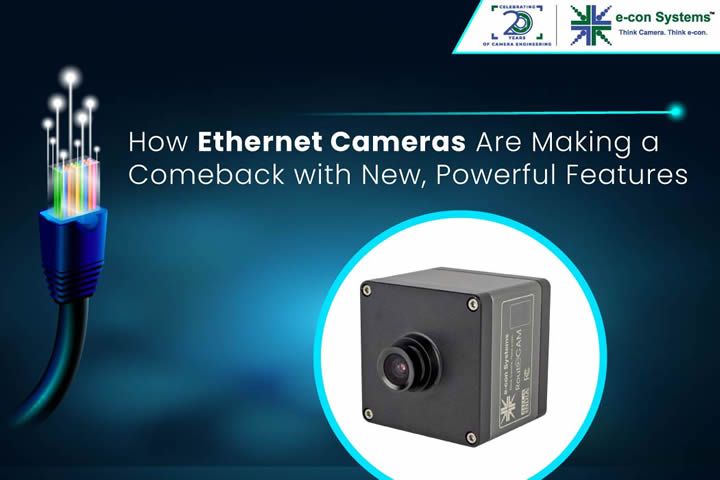In this blog, you’ll get expert insights about the role of Ethernet cameras in embedded vision, their challenges, and the exciting features that continue to make PoE technology extremely valuable.
Prabu Kumar | e-con Systems
The PoE (Power of Ethernet) technology was first standardized in 2003 with IEEE 802.3af, which offered up to 15.4 watts of power over Ethernet cables. The technology evolved, and with development of new standards, like IEEE 802.3at (PoE+) and IEEE 802.3bt (4PPoE), which provided a higher range for power delivery, led to the introduction of PoE cameras.
PoE technology enables data and power transmission through a single cable, making these cameras highly reliable and consistent and making the installation process more flexible and easy.
In this blog, you’ll get expert insights about the role of Ethernet cameras in embedded vision, their challenges, and the exciting features that continue to make PoE technology extremely valuable.
Challenges of Ethernet cameras in embedded vision
In the early days of integrating Ethernet cameras into embedded vision systems, there were several challenges. The primary issue was the limited bandwidth and speed of Ethernet technology at the time, which struggled to handle the high data throughput required for transmitting high-resolution images and video streams.
This hindered the ability of cameras to provide real-time video analysis and impaired the quality of the footage, especially in applications requiring detailed imaging or fast frame rates. Additionally, there were also compatibility issues with existing network infrastructures and protocols, leading to difficulties in seamless integration into broader security systems.
While some of these challenges have been overcome, others haven’t. Let’s take an in-depth look at some of the existing hurdles faced by Ethernet cameras.
1) Latency
Latency or delay occurs during the transmission of images and can have an impact on the overall performance of the system. When data transfer is not instant, system responsiveness is compromised. For example, in scenarios like real-time surveillance, even a slight delay in image transmission can lead to errors or missed opportunities for intervention.
This latency issue is compounded in environments with heavy network traffic or when transmitting high-resolution images, which require more bandwidth. As a result, Ethernet cameras, especially older models or those not optimized for low-latency transmission.
2) Bandwidth limitations
Generally, the bandwidth requirement is low for regular streaming. However, when Ethernet cameras are connected to embedded vision platforms, the bandwidth requirement is high due to various factors such as:
- Camera resolution and frame rate: Higher resolution cameras generate more data. For example, a camera capturing in 4K resolution will produce more data than one capturing in 1080p. Similarly, higher frame rates also increase data output. A camera at 60 fps will generate more data than one at 30 fps. This increased data rate demands more bandwidth.
- Color depth: An image’s color depth refers to the number of bits used for each color component of a pixel. Higher color depth means more detailed color information, resulting in larger file sizes. Hence, cameras with high color depth create more data to be transmitted over the network.
- Image compression: While compression techniques can reduce file size, they vary in performance. Some high-quality compression methods may not majorly reduce the size. So, uncompressed or lightly compressed images require more bandwidth for transmission.
- Packet size and overhead: Larger packet sizes transmit more data but face increased overhead. The overhead, which includes packet headers and other control information, consumes bandwidth, reducing the seamlessness of data transmission.
- Power over Ethernet (PoE): As you may know, PoE technology helps receive power and data over the same Ethernet cable. While convenient, it can trigger bandwidth constraints, especially if the network is powering multiple high-resolution cameras.
3) Security concerns
Ethernet cameras, as network-connected devices, operate over IP networks – making them potential targets for hacking and unauthorized data breaches. To counteract these risks, it’s important to implement advanced encryption protocols like AES (Advanced Encryption Standard) and secure data transmission.
Also, authentication mechanisms like two-factor authentication can be leveraged to ensure authorized personnel only get access. Other security measures can be taken, such as using firewalls and secure VPNs (Virtual Private Networks) and regularly updating firmware and software to address vulnerabilities.
How Ethernet cameras work in surveillance applications
Ethernet cameras in surveillance applications have significantly improved, increasing data transfer speed from 10 Mbps to 10 Gbps. This advancement facilitates the transmission of higher-resolution cameras and video streams, seamlessly transmitting 4K resolution videos and even supporting resolutions higher than 4K. The faster data transfer rates lead to reduced latency, crucial for real-time applications like robotics and autonomous systems.
There’s also an improvement in frame rates, benefiting applications requiring the capture of fast-moving objects or processes. Enhanced bandwidth supports more sophisticated image processing techniques, facilitating detailed analysis and rapid transmission of processed data. The 2010s saw the introduction of synchronization technologies such as Precision Time Protocol (PTP), Hardware Sync, and Network Sync, optimizing coordination across a network of cameras and enhancing surveillance.
With edge analytics and AI integration, Ethernet cameras now offer new functionalities like object recognition and anomaly detection, further increasing data transfer rates to accommodate the demand for higher-resolution images and video streams with AI capabilities.
New features of Ethernet cameras
Cloud and In-built storage
Embedded vision applications, which integrate image capture and processing directly within a camera, traditionally utilized SSD (Solid-State Drive) and HDD (Hard Disk Drive) for storing security video footage. This aligns with industry requirements and local regulations for footage retention. However, modern Ethernet cameras now incorporate a hybrid storage approach. They retain the traditional method of saving data on SSDs and HDDs but also leverage cloud storage for backup.
The hybrid model enhances the capabilities of embedded vision systems, offering greater reliability. It ensures that high-volume data generated by advanced image processing can be stored securely both locally and in the cloud, providing a comprehensive solution for modern security and surveillance needs.
Advanced PoE capabilities
The advanced Ethernet cameras come with PoE capabilities that eliminate the risk or cost of electrical wire. PoE cameras have stable data transmission capabilities, unlike wireless cameras, ensuring reduced interference from nearby devices. It is best to use STP or UTP cables.
Video data encryption
The security of Ethernet cameras depends upon data-level encryption and network security. The latest trends in high-resolution ethernet cameras ensure modern security standards are incorporated to prevent hackers from accessing the company’s sensitive information and turning off the whole system. At rest, encryption ensures data is protected while on camera; RSA and AES are two PKI (Public Key Infrastructure) encryption standards to ensure video data cannot be extracted from onboard storage. Meanwhile, in-transit encryption protects data while traveling over a network or being transferred from local storage to the cloud.
Edge-based video analytics
The latest Ethernet camera technologies have embraced AI and edge-based video analytics. These high-resolution cameras are now equipped to detect people and objects within their field of view, a leap forward from traditional video monitoring. The use of advanced software with deep learning capabilities enables these cameras to capture images while understanding and interpreting what they see in real-time. This approach to surveillance allows for more accurate monitoring.
Key highlights include:
- AI and deep learning: The cameras utilize artificial intelligence, specifically deep learning, to analyze video feeds intelligently. This allows the cameras can identify and differentiate between various elements in the scene.
- Facial and vehicle recognition: Enhanced with deep learning capabilities, these cameras recognize faces and vehicles. For instance, this can be crucial for alerting users about real-time incidents and can speed up investigations.
- Real-time processing: By processing data on the edge (directly in the camera), there’s a reduction in latency and reliance on cloud or central processing. It leads to quicker response times in security situations.
Integration with advanced platforms
Ethernet cameras can seamlessly integrate with advanced platforms for edge computing and AI applications, like robots. Next-gen platforms, like AGX Orin and Qualcomm RB5, can be utilized for the development of autonomous vehicles, robots, industrial automation, and other embedded systems.
Smart Odin by e-con Systems: Discover our latest world-class Ethernet camera
As a leader in designing, developing, and manufacturing OEM cameras for over two decades, e-con Systems has a proven track record, enabling customers to find the best imaging solution for their specific application needs.
SmartOdin, a 2MP GigE camera integrated with specially developed AI vision models, is one of our latest releases. This is an ONVIF-supported Ethernet Gigabit camera that can reliably send images and control data over a wired LAN network. Based on the 1/2.8″ Sony STARVIS IMX662 sensor, it comes with advanced AI capabilities like comprehensive object detection (Person, Bicycle, Motorcycle, Car, Bus, and Truck recognition) and facial recognition. Embedded within the EN675 EVK SDK, the dedicated NPU SDK also enhances the module’s AI power.
Key features:
- High Dynamic Range (HDR)
- Ultra low-light sensitivity & superior near-infrared performance
- Video data transfer with a maximum cable length of up to 100m
- 2 TOPS (max)
- FCAPS over cloud*
 Prabu Kumar is the Chief Technology Officer and Head of Camera Products at e-con Systems, and comes with a rich experience of more than 15 years in the embedded vision space. He brings to the table a deep knowledge in USB cameras, embedded vision cameras, vision algorithms and FPGAs. He has built 50+ camera solutions spanning various domains such as medical, industrial, agriculture, retail, biometrics, and more. He also comes with expertise in device driver development and BSP development. Currently, Prabu’s focus is to build smart camera solutions that power new age AI based applications.
Prabu Kumar is the Chief Technology Officer and Head of Camera Products at e-con Systems, and comes with a rich experience of more than 15 years in the embedded vision space. He brings to the table a deep knowledge in USB cameras, embedded vision cameras, vision algorithms and FPGAs. He has built 50+ camera solutions spanning various domains such as medical, industrial, agriculture, retail, biometrics, and more. He also comes with expertise in device driver development and BSP development. Currently, Prabu’s focus is to build smart camera solutions that power new age AI based applications.
The content & opinions in this article are the author’s and do not necessarily represent the views of ManufacturingTomorrow
Comments (0)
This post does not have any comments. Be the first to leave a comment below.
Featured Product


